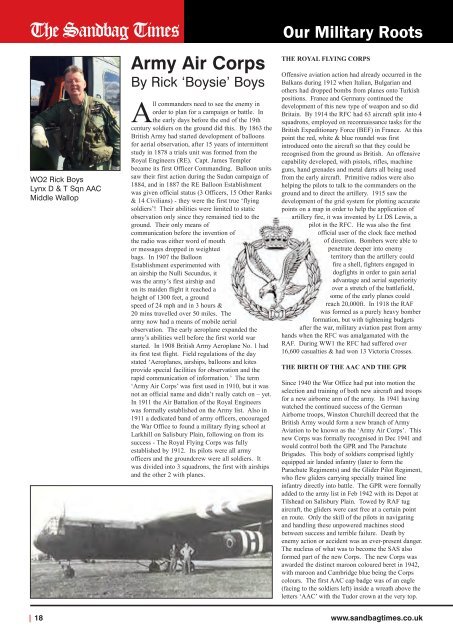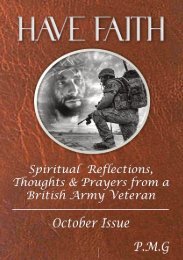Create successful ePaper yourself
Turn your PDF publications into a flip-book with our unique Google optimized e-Paper software.
WO2 Rick Boys<br />
Lynx D & T Sqn AAC<br />
Middle Wallop<br />
Army Air Corps<br />
By Rick ‘Boysie’ Boys<br />
All commanders need to see the enemy in<br />
order to plan for a campaign or battle. In<br />
the early days before the end of the 19th<br />
century soldiers on the ground did this. By 1863 the<br />
British Army had started development of balloons<br />
for aerial observation, after 15 years of intermittent<br />
study in 1878 a trials unit was formed from the<br />
Royal Engineers (RE). Capt. James Templer<br />
became its first Officer Commanding. Balloon units<br />
saw their first action during the Sudan campaign of<br />
1884, and in 1887 the RE Balloon Establishment<br />
was given official status (3 Officers, 15 Other Ranks<br />
& 14 Civilians) - they were the first true ‘flying<br />
soldiers’! <strong>The</strong>ir abilities were limited to static<br />
observation only since they remained tied to the<br />
ground. <strong>The</strong>ir only means of<br />
communication before the invention of<br />
the radio was either word of mouth<br />
or messages dropped in weighted<br />
bags. In 1907 the Balloon<br />
Establishment experimented with<br />
an airship the Nulli Secundus, it<br />
was the army’s first airship and<br />
on its maiden flight it reached a<br />
height of 1300 feet, a ground<br />
speed of <strong>24</strong> mph and in 3 hours &<br />
20 mins travelled over 50 miles. <strong>The</strong><br />
army now had a means of mobile aerial<br />
observation. <strong>The</strong> early aeroplane expanded the<br />
army’s abilities well before the first world war<br />
started. In 1908 British Army Aeroplane <strong>No</strong>. 1 had<br />
its first test flight. Field regulations of the day<br />
stated ‘Aeroplanes, airships, balloons and kites<br />
provide special facilities for observation and the<br />
rapid communication of information.’ <strong>The</strong> term<br />
‘Army Air Corps’ was first used in 1910, but it was<br />
not an official name and didn’t really catch on – yet.<br />
In 1911 the Air Battalion of the Royal Engineers<br />
was formally established on the Army list. Also in<br />
1911 a dedicated band of army officers, encouraged<br />
the War Office to found a military flying school at<br />
Larkhill on Salisbury Plain, following on from its<br />
success - <strong>The</strong> Royal Flying Corps was fully<br />
established by 1912. Its pilots were all army<br />
officers and the groundcrew were all soldiers. It<br />
was divided into 3 squadrons, the first with airships<br />
and the other 2 with planes.<br />
Our Military Roots<br />
THE ROYAL FLYING CORPS<br />
Offensive aviation action had already occurred in the<br />
Balkans during 1912 when Italian, Bulgarian and<br />
others had dropped bombs from planes onto Turkish<br />
positions. France and Germany continued the<br />
development of this new type of weapon and so did<br />
Britain. By 1914 the RFC had 63 aircraft split into 4<br />
squadrons, employed on reconnaissance tasks for the<br />
British Expeditionary Force (BEF) in France. At this<br />
point the red, white & blue roundel was first<br />
introduced onto the aircraft so that they could be<br />
recognised from the ground as British. An offensive<br />
capability developed, with pistols, rifles, machine<br />
guns, hand grenades and metal darts all being used<br />
from the early aircraft. Primitive radios were also<br />
helping the pilots to talk to the commanders on the<br />
ground and to direct the artillery. 1915 saw the<br />
development of the grid system for plotting accurate<br />
points on a map in order to help the application of<br />
artillery fire, it was invented by Lt DS Lewis, a<br />
pilot in the RFC. He was also the first<br />
official user of the clock face method<br />
of direction. Bombers were able to<br />
penetrate deeper into enemy<br />
territory than the artillery could<br />
fire a shell, fighters engaged in<br />
dogfights in order to gain aerial<br />
advantage and aerial superiority<br />
over a stretch of the battlefield,<br />
some of the early planes could<br />
reach 20,000ft. In 1918 the RAF<br />
was formed as a purely heavy bomber<br />
formation, but with tightening budgets<br />
after the war, military aviation past from army<br />
hands when the RFC was amalgamated with the<br />
RAF. During WW1 the RFC had suffered over<br />
16,600 casualties & had won 13 Victoria Crosses.<br />
THE BIRTH OF THE AAC AND THE GPR<br />
Since 1940 the War Office had put into motion the<br />
selection and training of both new aircraft and troops<br />
for a new airborne arm of the army. In 1941 having<br />
watched the continued success of the German<br />
Airborne troops, Winston Churchill decreed that the<br />
British Army would form a new branch of Army<br />
Aviation to be known as the ‘Army Air Corps’. This<br />
new Corps was formally recognised in Dec 1941 and<br />
would control both the GPR and <strong>The</strong> Parachute<br />
Brigades. This body of soldiers comprised lightly<br />
equipped air landed infantry (later to form the<br />
Parachute Regiments) and the Glider Pilot Regiment,<br />
who flew gliders carrying specially trained line<br />
infantry directly into battle. <strong>The</strong> GPR were formally<br />
added to the army list in Feb 1942 with its Depot at<br />
Tilshead on Salisbury Plain. Towed by RAF tug<br />
aircraft, the gliders were cast free at a certain point<br />
en route. Only the skill of the pilots in navigating<br />
and handling these unpowered machines stood<br />
between success and terrible failure. Death by<br />
enemy action or accident was an ever-present danger.<br />
<strong>The</strong> nucleus of what was to become the SAS also<br />
formed part of the new Corps. <strong>The</strong> new Corps was<br />
awarded the distinct maroon coloured beret in 1942,<br />
with maroon and Cambridge blue being the Corps<br />
colours. <strong>The</strong> first AAC cap badge was of an eagle<br />
(facing to the soldiers left) inside a wreath above the<br />
letters ‘AAC’ with the Tudor crown at the very top.<br />
| 18 www.sandbagtimes.co.uk


















